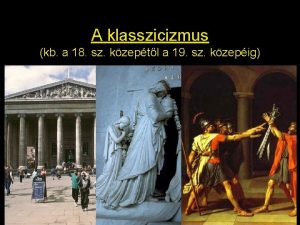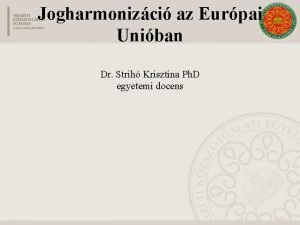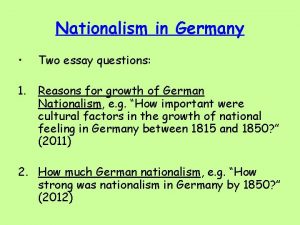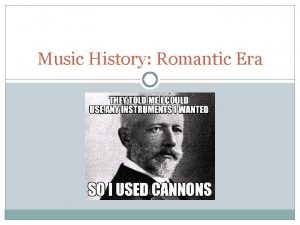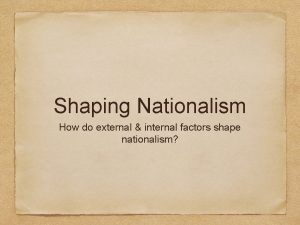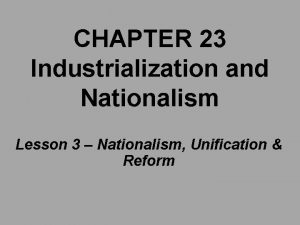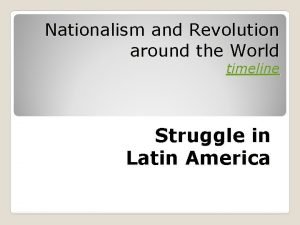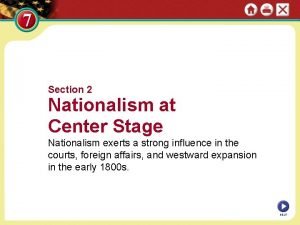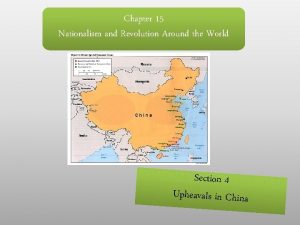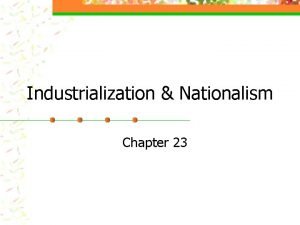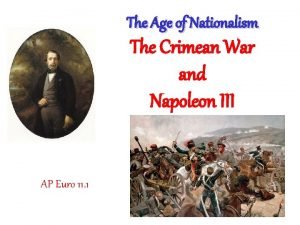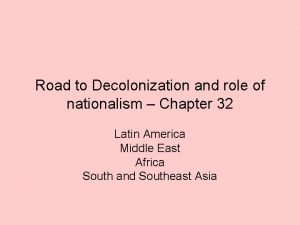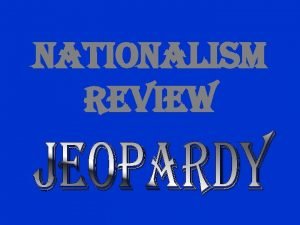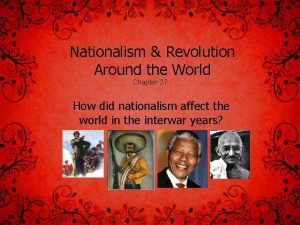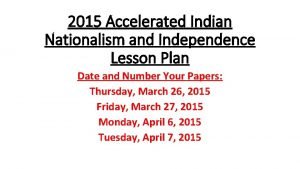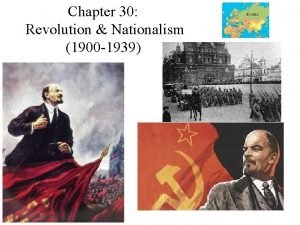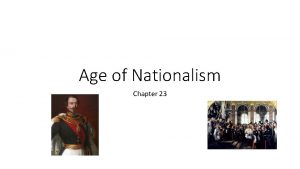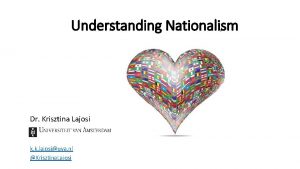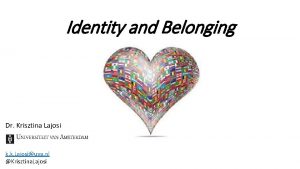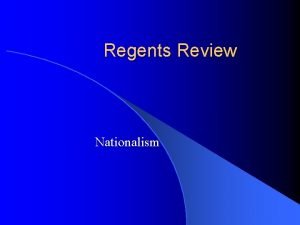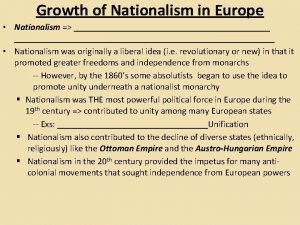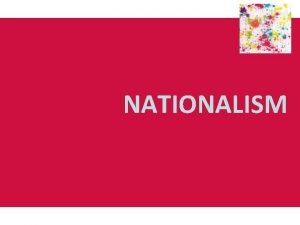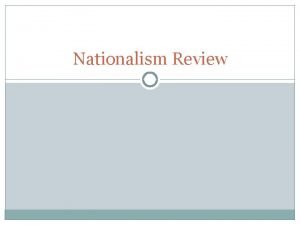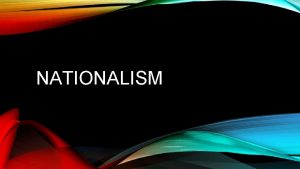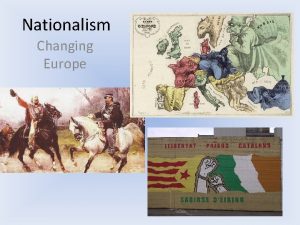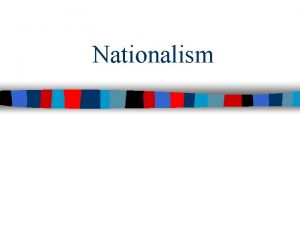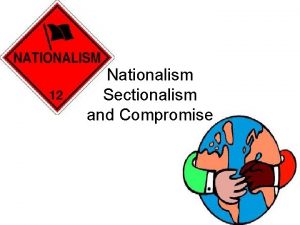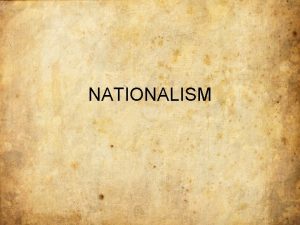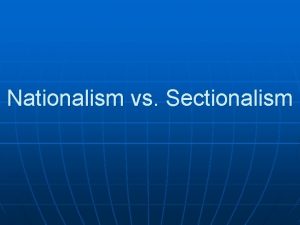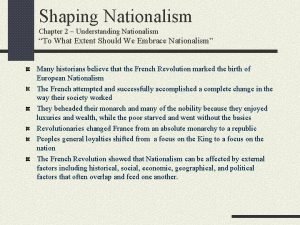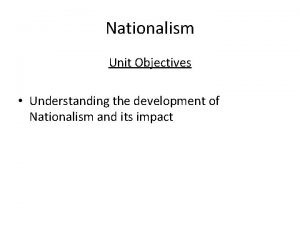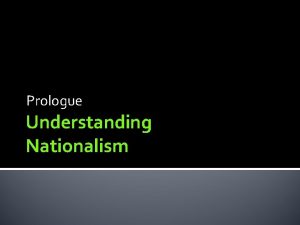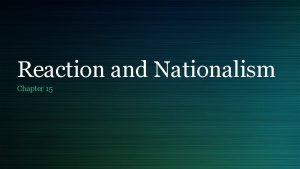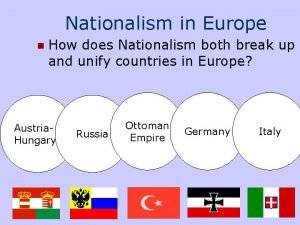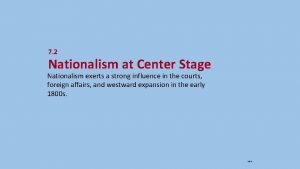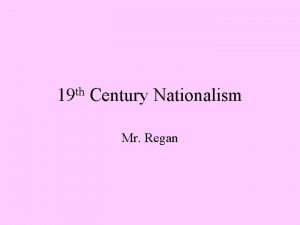Understanding Nationalism Dr Krisztina Lajosi k k lajosiuva






























- Slides: 30

Understanding Nationalism Dr. Krisztina Lajosi k. k. lajosi@uva. nl @Krisztina. Lajosi

Nations, states, peoples, identities, citizenship

Multiple national identities and citizenships

Discussion points 1. What is nationalism? 2. Historical emergence of nationalism (studies) 3. Various types of (approaches to) nationalism 4. National consciousness, national identity 5. Nationalism vs. patriotism 6. Nationalism today

What is nationalism? • “Nationalism is a doctrine invented in Europe at the beginning of the nineteenth century. It pretends to supply a criterion for the determination of the unit of population proper to enjoy a government exclusively its own. ” (Elie Kedourie: Nationalism, 1960) • “Nationalism is primarily a political principle, which holds that the political and the national unit should be congruent. ” (Ernest Gellner: Nations and Nationalism, 1983) • The nation “is an imagined political community – and imagined as both inherently limited and sovereign. ” (Benedict Anderson: Imagined Communities, 1983) • “The national phenomenon cannot be adequately investigated without careful attention to the ‘invention of tradition’. ” (Eric Hobsbawm and Terence Ranger: The Invention of Tradition, 1983) • “Nationalism, far from being an intermittent mood in established nations, is the endemic condition. ” (Michael Billig: Banal Nationalism, 1995)

Father figures of nationalism studies Elie Kedourie (1926 -1992) Ernest Gellner (1925 -1995) Benedict Anderson (1936 -2015) Eric Hobsbawm (1917 -2012)

Non-European Nationalism Scholars Nira Yuval-Davis (1943) - gender and nationhood Partha Chattarjee (1947) - (de)colonization and nationalism

Nationalism studies vs. Methodological nationalism Critical Nationalism Studies Methodological Nationalism - reflects on the constructed nature of nationhood - contests the nation as a political and cultural category - considers the national as part of the global - accepts the nation as a given historical category - sees the nation/state as a given and often as a natural and universal unit

Two opposing approaches to nationalism/nationhood Essentialism Constructivism

Major paradigms of nationalism Primordialism - an essentialist way of looking at nations, based on: A. a sociobiological approach and B. cultural rootedness - claims that nationality is a natural feature of humans (like smell, sight, or language) and has existed since the beginning of time; - has gained a negative reputation (fixity, essentialism, finalism). Perennialism - nations (at least some nations) have always existed, but have changed throughout history; - nations are not considered as natural, organic, or primordial; - emphasis on continuity. Modernism - nations are the result of processes of modernization and industrialization, urbanization, and capitalism; - there is nothing inherently natural or essential about nations; - Gellner, Anderson, and Hobsbawm are all “modernists. ”

Nationalism claims that … • nations are natural and universal • nations are perennial (enduring and continually recurring) • every nation should have its own state • nations are sovereign • national boundaries and political/territorial borders should be congruent • loyalty to the nation comes first

Nationalists aim to establish … national unity national identity national autonomy nationstate

How old are the European nations? https: //youtu. be/YN 0 p. Gphq. RS 0? t=62

Conceptual confusions nation state people country race

What is a nation? • a nation is a community of people with a common culture (and usually language), sharing a sense of collective identity and belonging, and pursuing political self-determination (but not necessarily statehood) and autonomy within a certain territory. • a nation is bigger than an ethnic group, and is usually the result of a fusion of various cultural communities (ethnic groups, language communities, tribes) who share a will to have a common culture and political future together.

Ethnic groups or ethnies Ethnic groups have • a common proper name to identify the group; • a myth of common ancestry and kinship; • shared historical memories; shared memories of a common past including heroes, important events, etc. ; • one or more elements of common culture including a common language, religion, customs, etc. ; • a link with a real or mythical land, a symbolic attachment to a homeland or ancestral land; and • a sense of belonging to the same community and solidarity towards the other members of the same group. (John Hutchinson and Anthony D. Smith, Ethnicity, Oxford: Oxford University Press, 2009, 6 -7. )

Nation vs. State Nation - people with a common cultural and historical consciousness and a sense of belonging - Emotional & cultural (& political) bonds State - Independent political entity with clearly defined borders and legal status - Political, legal, social & cultural institutions

Not all nations have their own state nation state

Multiethnic states and nations ethnic group 1 ethnic group 2 ethnic group 3 state

From nationality to nation-state people • Populace inhabiting a certain territory • Ethnic groups nation • communities with a sense of belonging and common cultural & historical consciousness • Social, cultural & political category nationstate • Political and geographical category • Sovereign political entity • Product of 19 thcentury nationalism

Two main types of nationalisms: ethnic & civic Ethnic nationalism Civic nationalism

Cultural homogeneity

Civic and ethnic nationalism are often intertwined

National consciousness / National identity culture history National identity myth emotions

Identity construction by othering Identity/sameness selfhood Otherness/alterity othering

nationalism / patriotism / populism Nationalism –» loyalty to and love of the nation / the national community; positive feelings towards the nation; competitive in nature; (“My nation first. ”) Patriotism –» loyalty to the country; territorial loyalty; positive feelings toward the country; not necessarily competitive; Populism –» loyalty to the people; “the pure people” vs. “corrupt elite”; politics should represent “the will of the people” (Mudde and Kaltwasser: Populism, Oxford: Oxford University Press, 2017); • Patriotism and nationalism – share the same logic, motivation, and symbolism; • Populism can be nationalist, but not necessarily; nationalism can be populist, but also not necessarily, since nationalism can also be élite-driven and élite-focused;

Nationalism today Revolves around the issues of: • Sovereignty • Solidarity • Sustainability • Migration • Globalization • Economy • Welfare state • Sub-state nationalism Image by Paresh Nath, The Khaleej Times, UAE

Beyond the Fringe (1961) – from 5’ 14 min to 6’ 08 “Commentary on America – What is America? ” https: //youtu. be/CXLGVDOd 7 yk? t=314

Sources of the images: Slide 1 - https: //www. wur. nl/en/activity/SG-Nationalisms-Comeback-Understanding. Nationalism. htm Slide 4 - http: //martinkramer. org/sandbox/reader/archives/elie-kedourie/ and https: //en. wikipedia. org/wiki/Ernest_Gellner and https: //en. wikipedia. org/wiki/Benedict_Anderson and https: //www. prospectmagazine. co. uk/magazine/eric-hobsbawm-marxist-history-ramachandraguha Slide 5 - https: //theconversation. com/profiles/nira-yuval-davis-302905 and https: //cgt. columbia. edu/about/people/committee-faculty/partha-chatterjee/ Slide 8 - https: //youtu. be/YN 0 p. Gphq. RS 0? t=62 Slide 9 – http: //www. geoatlas. com/en/maps/flags-8/flags-of-europe-5004 Slide 10 - https: //www. wincodev. com/edu-course/pitch-a-linternational/ Slide 18 - https: //www. cartoonstock. com/cartoonview. asp? catref=atan 56 Slide 19 - http: //renoirclioblog. over-blog. com/article-carnavalet-fait-sa-revolution-37689937. html and https: //abp. bzh/apres-l-integration-l-assimilation-et-apres-l-assimilation-la-destruction-36987 Slide 23 - http: //www. caglecartoons. com/viewimage. asp? ID={12 E 790 B 9 -81 C 0 -4810 -88 AFA 4 FDD 0 B 33 D 09} Slide 24 - https: //youtu. be/CXLGVDOd 7 yk? t=314

THANK YOU! Any questions?
 Szabó krisztina bme
Szabó krisztina bme Ferenczy istván pásztorlányka
Ferenczy istván pásztorlányka Morvai krisztina betegsége
Morvai krisztina betegsége Geng viktor
Geng viktor Rúzs molnár krisztina szte
Rúzs molnár krisztina szte Strihó krisztina
Strihó krisztina Szabó krisztina bme
Szabó krisztina bme Strihó krisztina
Strihó krisztina Strihó krisztina
Strihó krisztina Strihó krisztina
Strihó krisztina Nguyen krisztina
Nguyen krisztina Krisztina gecse amsterdam
Krisztina gecse amsterdam Phenobarbitál
Phenobarbitál Nationalism wwi
Nationalism wwi Nationalism in india and southwest asia
Nationalism in india and southwest asia Political nationalism
Political nationalism The deliberate intent to draw creative inspiration
The deliberate intent to draw creative inspiration Internal and external factors of nationalism
Internal and external factors of nationalism Chapter 23 lesson 3 nationalism unification and reform
Chapter 23 lesson 3 nationalism unification and reform Nationalism and revolution around the world
Nationalism and revolution around the world Chapter 7 section 2 nationalism at center stage
Chapter 7 section 2 nationalism at center stage Nationalism and revolution around the world
Nationalism and revolution around the world Industrialization and nationalism
Industrialization and nationalism Crimean war nationalism
Crimean war nationalism Nationalism and decolonization
Nationalism and decolonization Nationalism
Nationalism When did mao take over china
When did mao take over china What's the difference between nationalism and sectionalism
What's the difference between nationalism and sectionalism Indian independence lesson plan
Indian independence lesson plan Russian revolution vocabulary
Russian revolution vocabulary Chapter 23 the age of nationalism
Chapter 23 the age of nationalism

